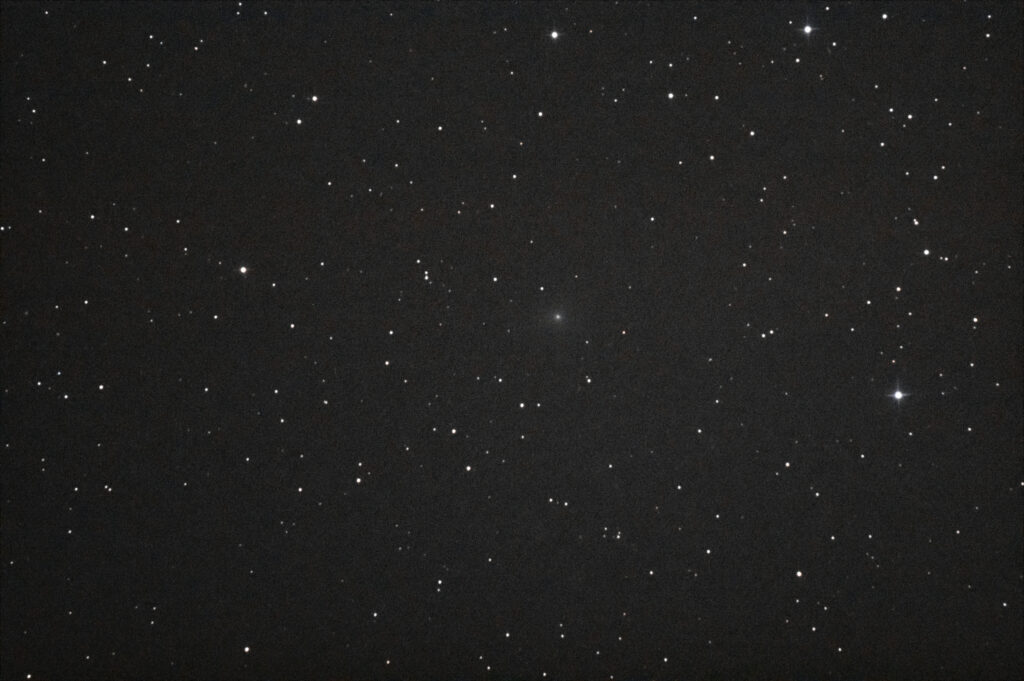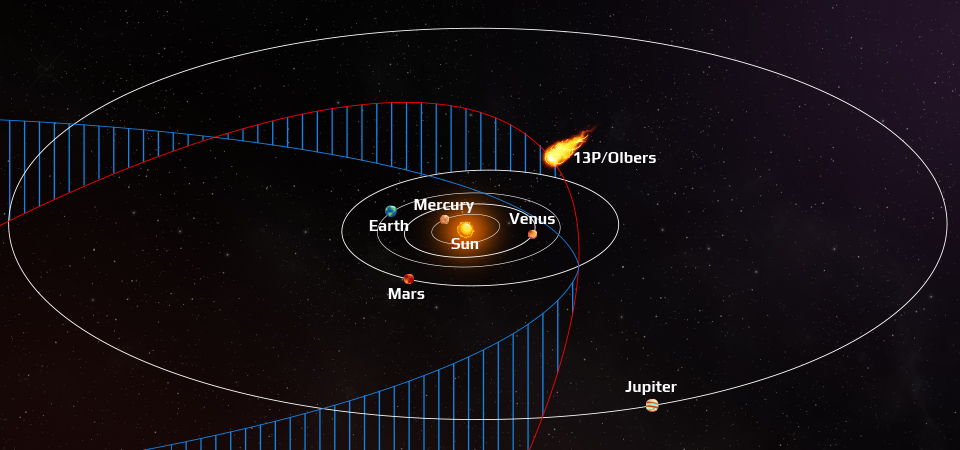Only recently, the comet Pons-Brooks “escaped” from our sky to the Southern Hemisphere, and the next representative of the Neptune family, the Olbers’ comet (13P/Olbers), is already approaching us. It will not be as bright as its predecessor, and the conditions for observing it will be much worse. With a sufficiently powerful telescope, it can already be found in the evening sky in the constellation Taurus. Let’s try to figure out how to do this and what to expect from the “tailed visitor” in the near future.
The comet is named after the German astronomer Heinrich Olbers, known for discovering two of the “first four” asteroids — Pallas and Vesta — and being the first to suggest that these objects are not the last ones out there. On the night of March 6-7, 1815, while conducting observations at his observatory in Bremen, he noticed a small nebula in the constellation of the Giraffe, which was moving quite rapidly against the background of the stars. Within a month, the approximate parabolic orbit of the new celestial body was calculated, and in July of the same year, the famous German mathematician Friedrich Bessel proved that this orbit should actually be elliptical with a period of 73 years. Further, the calculations continued to be refined, but in its next appearance, the comet was accidentally rediscovered by the famous American “comet hunter” William Brooks (therefore, in fairness, it should be called “Olbers-Brooks”). This happened on August 25, 1887.

This “tailed star” became the third confirmed representative of the Neptune comet family, whose orbital periods range from 50 to 200 years. The first two were the famous Halley’s comet and the already mentioned Pons-Brooks comet. Over time, the period of 13P/Olbers’ orbit around the Sun slightly decreased under the influence of the gravity of the large planets, and its next return took place in 1956. It was quite favorable for observations: during it, the comet’s brilliance was only slightly below 6th magnitude.
Another rediscovery of Olbers’ comet was made by the famous American astronomer Alan Gale. It happened on Ukraine’s Independence Day, August 24, 2023. Refined data on its position made it possible to calculate that the “tailed guest” will pass perihelion on June 30, 2024, at a distance of 1,176 AU (176 million km) from the Sun. In general, the conditions of its visibility this year are much worse than in the previous appearance. For almost the entire period when the comet’s brilliance is high enough to be seen through amateur telescopes, it will be less than 40° from our luminary, and we will be able to observe it only due to a sufficiently large positive declination.

On April 25, the Moon will disappear from the evening sky, and at the end of astronomical twilight — around 10 pm Kyiv time —Olbers’ comet will be found 11° above the northwestern horizon, 9° to the left and above Pleiades. Its angular distance from the Sun (elongation) on this day will be 33°, and its brilliance will reach 9th magnitude. It will remain within the conventional limits of the constellation Taurus until May 6. On May 9-10, a thin lunar sickle will pass near it.
From then on, it will be increasingly difficult to “catch glance” of the comet; in the middle of astronomical twilight, its height above the horizon will not exceed 7°, and in the northern regions of Ukraine it will be slightly better visible. In the evening of May 21, it will pass near the scattered cluster M36 in the constellation of the Auriga, with a brilliance slightly below 8 ᵐ (the total brilliance of the stars in the cluster is 6.5 ᵐ). And on the last day of spring, the angular distance between 13P/Olbers and the Sun will reach a minimum of 25°50′. In fact, on this day, the “tailed star” will be separated from our luminary by 1.26 AU (188 million km), and from the Earth by 2.093 AU (over 300 million km).
On June 11, the declination of Olbers’ comet will exceed 40°, and it will no longer go beyond the horizon for observers at 50° N. On June 18, it will move from the constellation of Auriga to the Lynx, with its brilliance reaching 7.5ᵐ and elongation reaching almost 28°. In Kyiv on this day, the navigational twilight will end at about 11 pm summer time (astronomical twilight will directly transition from evening to morning), at which point the comet can be found at 13.5° above the northeastern horizon, 10° north of the star Castor (α Gemini).

On June 30, as already mentioned, 13P/Olbers will pass perihelion, and on the same day its declination from the point of view of ground-based observers will reach its maximum value in this appearance – 42°19′. On this day, the angular distance of the comet from the Sun will only slightly exceed 30°, but its brilliance will increase to almost 7th magnitude, making it much easier to find even in the twilight sky.
On July 13, the comet will enter the small constellation of the Leo Minor, and a week after that it will be at the minimum possible distance from Earth in its current appearance – 1,895 AU (284 million km). During this time, its luminosity will slowly decrease, but it will still remain above 8th magnitude, and then it will begin to decline much faster. On July 27, it will “crawl” into the Big Dipper, and only after that, in our latitudes, it will be possible to observe it in a normal dark sky: at the end of astronomical twilight, the “tailed guest” will be 11° above the horizon, which is actually not much.
On August 12, 13P/Olbers will move to the constellation of Coma Berenices, still having an overall magnitude above 9th magnitude, which will make it easy to observe with small astronomical instruments. On August 15-18, it will be visible against the background of the Crane’s Wedge star cluster, on the evening of August 25 it will pass 0.5° north of the Black Eye galaxy M64, and on August 30 it will be less than a degree away from the globular cluster M53.
On September 7, the comet will finally cross the conditional boundary of Boötes, being at 38° from the Sun. Three days later, the Moon will appear in the evening sky with the accompanying light, making observations much more difficult. In the middle of the month, the brightness of 13P/Olbers will drop to 10th magnitude, and on September 25 it will “crawl” to the zodiacal constellation Virgo. Every evening, at the end of astronomical twilight, it will appear lower and lower on the horizon.
Finally, in the evening of October 15, a rather rare “comet meeting” will take place: less than a degree north of 13P/Olbers the recently discovered comet C/2023 A3 (Tsuchinshan-ATLAS) will pass. This latter comet promises to be the brightest “tail star” of the year. It will take place against the backdrop of the constellation Serpens, not far from the globular star cluster M5. Unfortunately, the protagonist of this article will have faded to 11th magnitude by then, so it will be almost impossible to find it in the twilight sky at 8-9° above the horizon, even with powerful telescopes.
To get as close to Earth as possible (a little over 0.5 AU), Olbers’ comet would have to return to the Sun about 4 months earlier. Then, at the beginning of the year, we would have easily seen it with the naked eye, practically in opposition. Interestingly, it will appear in a configuration very close to the optimal one next time. According to the updated data, in January 2094, this comet will come closest to us since its discovery – then the distance to it will be 0.676 AU, or 101 million km. It will be at its perihelion on March 15.
A map of the path of Olbers’ comet from April to September this year can be found here.

